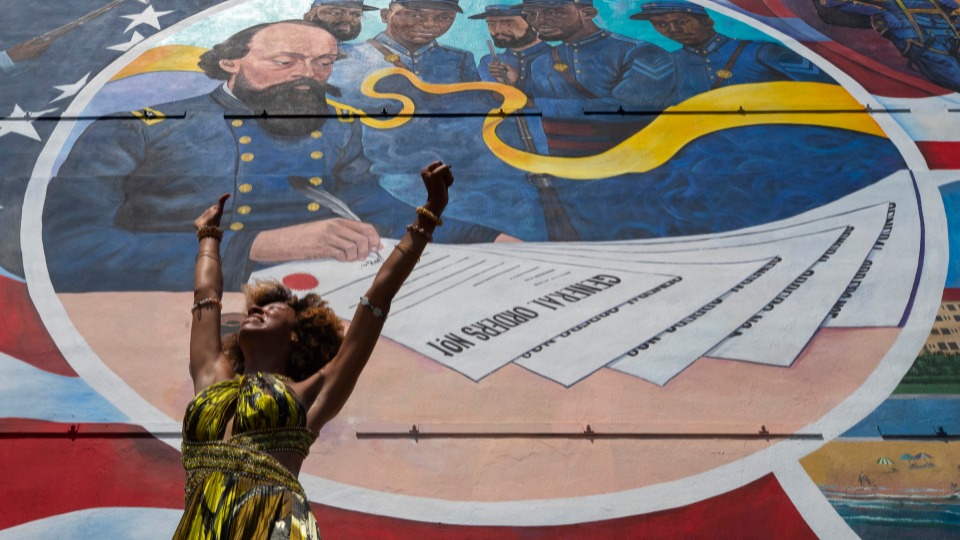
Black History has the power to uncover the truth and expose the lies about the key contributions Black people have made to winning democratic rights for all. This is especially true of the Civil War and Reconstruction. That was a crucial time in American history that has been “falsified,” as W.E.B. DuBois said. In his 1935 groundbreaking book, Black Reconstruction, DuBois sets the record straight. The North “had to call in the black men to save the Union, abolish slavery, and establish democracy.”
Juneteenth: The First General Strike
On “Juneteenth” 1863, when Lincoln announced his decision to issue the Emancipation Proclamation, he was only recognizing the facts on the ground. Hundreds of thousands of enslaved people had already freed themselves and run away, depriving the slaveowners of their workforce. Of those who remained on the plantations, the owners complained that many were refusing to work. DuBois called it “the first General Strike.”
Over 180,000 of the self-freed men joined the Union Army. Their families often joined the men and worked for the Union Army. That turned the tide of the Civil War that the North had been losing.
The question could be asked, “Why was the North losing the Civil War although they had superior resources and over three times the population?” That was partly due to the ongoing, almost permanent military nature of the Southern states, already mobilized to keep 3.5 million people enslaved. Also, the morale of the poor white farmers and workers who were drafted into the Union Army was not always high.
It was true that working people were strongly anti-slavery. Whole union locals had dissolved to volunteer for the Union Army at the start of the war. But the rich never enlisted. For $300, they could buy their way out of serving. That was not an option for workers, many of whom made less than $500 a year. Meanwhile, the war was enriching the bankers, the new monopoly capitalists, and the expanding railroad companies. Growing inequality was undermining Union morale.
Black soldiers turn the tide
The massive influx of dedicated Black freedom fighters, who joined the Union Army in regiment-size contingents, led to a resounding victory. The Civil War could not have been won without them. Still, in the early days of the Civil War, the Union Army had the shameful policy of returning escaped, enslaved people to their masters! But General Frémont, in the border state of Missouri, recruited officers who rejected this outrageous practice.

Generals Joseph Weydemeyer, Franz Sigel, and August Willich—immigrant German Communists and friends of Karl Marx—emancipated the enslaved wherever they marched. Lincoln disapproved and reassigned Frémont elsewhere. But the die had already been cast. The decision had been made by the hundreds of thousands of Black people escaping the plantations to fight for freedom.
The Union victory unleashed the creative energies of 3.5 million freed men, women, and children, who rushed into the newly opened political arena. Freedmen joined already-free Black people to organize state conventions. Attendance at Black political events was so massive that employers complained nobody worked on meeting days. What was at stake included ownership of the plantations that had been confiscated from the rebel owners, and political rights—especially the right to vote. What kind of new South would Reconstruction create?
The tragic assassination of Lincoln was a huge setback. Pro-slavery Andrew Johnson became president. He pardoned 7,000 Confederate leaders and allowed Southern state legislatures that enacted “Black Codes” to force Freedmen and women back to plantations. But Johnson was stopped in his tracks. The veto-proof Radical Republican majority of Congress rose up and impeached him. Johnson was saved from removal by just one Senate vote.
With Congress in charge, real Reconstruction began, and new state legislatures were elected with substantial Black composition. Black men won the right to vote in state elections and run for office well before the 15th Amendment established that right nationally.
Reconstruction and new democratic rights
A lasting achievement of Reconstruction was the creation of a public school system in the South. As Eric Foner said in a recent interview with Chicago’s PBS network WTTW: “At the end of the Civil War, even while the war’s still going on in some areas, and then immediately after, there’s this explosion of energy in Black communities to create schools. Northern aid societies come down to help create schools. The Freedmen’s Bureau puts money into creating schools. But most of the schools that spring up are actually created by Blacks themselves.”
Other lasting achievements were the 13th, 14th, and 15th Amendments to the U.S. Constitution. They laid the basis for the democratic rights that we are working to defend and extend today. The 13th Amendment, for the abolition of slavery throughout the U.S., passed in 1865. The 14th Amendment, for birthright citizenship and equal rights under the law, passed in 1866. By 1869, the 15th Amendment passed Congress, extending the freedmen’s right to vote nationally. That amendment did not include women’s suffrage, although Black leaders had fought for voting rights for all, women as well as men.

For the first time ever, in both North and South, significant numbers of Black men were elected or appointed to public office. Over 4,000 Black men became public officials, counting federal, state, and local public offices. That was a most important achievement, but it could not outlast the return of political power to ex-Confederate plantation owners. The crucial issue of survival of democratic rights was tied to land reform. Who should own the plantations that were either abandoned or confiscated from Confederate traitors?
Reconstruction, an “Unfinished Revolution”
There was a successful land reform model that could have established a huge economic base for democracy in the South. Gen. Sherman’s “Special Field Order 15” gave 14,000 Black families in South Carolina 40 acres each along the Charleston rice coast and the Sea Islands. Sherman also offered to lend mules.
Instead, most of the confiscated plantations were “returned” to the former slaveowners who had fought to destroy the Union. That left most freedmen and freed women with no way to make a living except to go back to the plantation under semi-serf conditions. In that basic economic and political sense, the Reconstruction Revolution remained unfinished.
Withdrawal of the Union Army from the South in 1877 ended Reconstruction and returned full power to the former slaveowners and their Ku Klux Klan. Then salt was added to these mortal wounds to the body of Democracy. The very same Union Army regiments that had protected Reconstruction were withdrawn to smash the National Railroad Strike of 1877 and to fight genocidal wars against Native Americans.
Meanwhile, vast economic and political changes had been taking place in the North and West. Banks and corporate monopolies began to dominate the economy. By May 10, 1869, railroads crossed the continent from the Atlantic to the Pacific. They were subsidized with huge land grants of Native American land. Having already forced Native Americans off their lands east of the Mississippi, the U.S. was waging genocidal wars to seize Native American lands in the West. In the cities and towns, wage workers were rising up and joining unions to cut the 12-hour work days and to fight for an 8-hour day.
The growing dominance of monopoly capital and imperialist changes in the North, and the failure to complete Reconstruction in the South, set our country on its present dangerous path. It’s a path of racism and oppression at home and eternal war and imperialism abroad. Many have called the Civil Rights Movement of the 1960s and ’70s, “the Second Reconstruction.” It is time for a “Third Reconstruction” to finish the Reconstruction Revolution left unfinished in 1877.
Thousands of heroes
Black Reconstruction brought forward thousands of heroes. To begin with, the thousands of Black public officials were all heroes. They served despite frequent terrorist attacks that also targeted their families. There were many more thousands of heroes whose names we don’t know.
Fortunately, a whole corps of historians, Black and white, are now doing research in the spirit of W.E.B. DuBois. They are bringing more heroes’ names to light, such as Sergeant Fred Brown and State Legislator Abraham Calloway. Joseph T. Glatthar has written about Brown in Forged in Battle, the Civil War Alliance of Black Soldiers and White Officers. The Regiment Commander had been alerted to a plot to destroy the 33rd U.S. Colored Infantry when they relocated by train. The commander ordered Brown to take four privates, ride on the engine, and shoot the engineer if anything went wrong.
On a trestle bridge, 100 feet above the water, someone pulled a pin, uncoupling the engine. The engine sped on, leaving the regiment trapped aboard the cars, up in the air. Just then, volleys of musket fire poured into the cars. It was nighttime, so the soldiers could not see to return effective fire. Nor could they abandon the cars. It seemed hopeless.
Just then they heard the engine backing up, returning. When the two sections were reconnected, the commander noticed that Sgt. Brown had his pistol cocked, snug against the back of the engineer’s head. Evidently, Brown had threatened to blow the man’s brains out unless he backed up his engine immediately. Brown’s quick thinking had saved the whole regiment.
Abraham Calloway
Born enslaved in 1837, Abraham Galloway escaped to freedom when only 20 years old. But he returned to North Carolina to rescue his mother, and again to help the North win the Civil War. Only 26, Galloway and his men held a gun to the head of the Union Army recruiter until they won the promise they needed. The recruiter promised equal pay for the new Black recruits, schools for their children, jobs for women, and provisions for their families.

Above all, was the demand that the Union Army would force the Confederacy to treat captured soldiers as prisoners of war and not re-enslave or execute them. Within six days, Galloway returned with 6,000 recruits, enough for a brigade.
The very next year, Galloway led a delegation of self-freed men to present President Lincoln with a petition calling on him to “…finish the noble work you have begun, and grant to your petitioners that greatest of privileges, when the State is reconstructed, to exercise the right of suffrage.”
One of only 13 Black delegates among the 120 men elected to the State Constitutional Convention, Galloway declared, “I came here to help the poor white man, as well as the colored man, and to do justice to all men.”
Elected twice to the State Senate, Galloway voted to ratify the 14th and 15th Amendments to the U. S. Constitution. He introduced a bill to limit the workday to ten hours. Galloway also sponsored bills for women’s suffrage and against domestic violence. But these bills did not pass. Galloway was especially eloquent on the subject of public education: “They hunger for the ‘forbidden fruit’ of knowledge with a zest of appetite which imparts marvelous powers of acquisition.”
Abraham Galloway died, cause unknown, at 33. He had just escaped two assassination attempts. Although he died broke, 7,000 people came to his funeral in Wilmington, N.C. His unrelenting fight for freedom, just as the even less known bravery of Sgt. Brown, continues to inspire us today.










